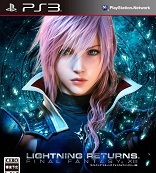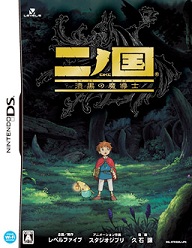Digimon World Dawn
Nintendo DS
Reviewed: 10/31/2007
 The Digimon series has often been plagued by lackluster titles which fail to really capitalize on the potential of its concept of digital monsters. While Digimon World Dawn is rough around the edges, hampered by low production values and a lousy script, the in-depth yet simplistic gameplay highlights this title as one of the best in the Digimon World series, following very closely in the footsteps of Digimon World DS, and makes the game worthwhile even for non-fans of the franchise.
The Digimon series has often been plagued by lackluster titles which fail to really capitalize on the potential of its concept of digital monsters. While Digimon World Dawn is rough around the edges, hampered by low production values and a lousy script, the in-depth yet simplistic gameplay highlights this title as one of the best in the Digimon World series, following very closely in the footsteps of Digimon World DS, and makes the game worthwhile even for non-fans of the franchise.
One of the largest components of a monster training RPG is the battle system. Fortunately, in Digimon World Dawn, battles are a smooth-flowing and fast-moving affair. In battle, players may select three main team members, which they array on a five-square line, and keep three reserves in the wings for swapping in and out. They will face off against one to five opponents, in first-person view, on the same five-square line. Placement is important, because each skill will hit a different range of squares on the board. Placing ally Digimon next to each other will bring stat boosts, but attacks that hit clusters of squares are more common than separated squares, which means that they will also be marginally more vulnerable. Of course, this matters less in the late game, when many foes can use attacks that hit the whole grid anyways. Items also play an important role in placement, as almost every item has incarnations that can hit either one, two or three squares in a row. Turn order appears on the left side of the top screen, constantly reordering itself when combatants are KO’ed or have their speed altered. A Digimon may on its turn perform one of five attacks (one species-specific attack, and four accumulated skills), defend adjacent Digimon, flee, move around the grid or swap with a reserve, or use an item.
 |
| The Dawn-exclusive posterboy |
Easily the best part of Digimon World Dawn is the Digivolution system. Defeating foes will net all Digimon in the party species experience, based on what Digimon type the enemies were. The total collected species experience determines when Digimon level up, but specific types and amounts of experience are often required for Digivolving from one form to another. Every Digimon has a different Digivolution Route, which typically contains seven to twelve forms that it may turn into. Moving forwards to a more powerful form along one of the paths will require more difficult prerequisites, such as a high level or large amounts of species experience, while moving backwards will require simpler prerequisites. No matter which way a Digimon evolves, its Aptitude stat (which determines the maximum level that Digimon may reach) will increase, and all learned skills will be retained. Digivolving retains 90-105% of the original Digimon’s stats (depending on the direction) and drops its level back down to 1, allowing it to quickly gain levels all over again. Creating an ultimate team of Digimon will mean a lot of forwards and backwards evolution through many different forms.
Rather than becoming repetitive and dull, this helps to refresh level-grinding by decreasing the amount of experience a Digimon must gain to level up and grow stronger: the gap between Level 1 and Level 2 is far, far smaller than Level 57 and Level 58. Newly Digivolved creatures will have their stats grow in leaps and bounds. This keeps up well with the game’s difficulty level, which is relatively easy as long as one is actively managing their team of Digimon. Another nice perk is the Farm Island, which will allow up to 32 Digimon outside the main party of six to gain extra stats and experience as time passes in game. Overall, the gameplay is addictive and creates feelings of involvement rather than detachment, since the player has large amounts of control over the direction each Digimon will take. Digimon World Dawn adds many welcome aspects on to a typical monster training game.
Another nice touch is that all of the aspects of customization in the game are available nearly simultaneously. Once the game has started in earnest, Digimon tamers will have full access to all aspects of the system, including the Special Digivolutions, which allow two Digimon to be combined into a new one, and Digiconversion, which allows players to acquire new Digimon based on scan data acquired from defeated Digimon.
Digimon World: Dawn‘s story is perfunctory at best, since the meat of the game clearly lies in the monster-training gameplay, but what is present is rather predictable and lame. The back of the box says it better than I ever could:
 |
| And the cactus in a poncho has a default name of Ponchomon. Genius. |
“Join Light Fang, a powerful team of Digimon Tamers to fight a mysterious enemy supposedly sent by your rival Tamers in Night Claw!”
Supposedly? That sounds kind of suspicious. But wait! Don’t look at the Dusk box, or the whole thing will be spoiled!
“Join Night Claw, an elite team of Digimon Tamers to fight a mysterious enemy supposedly sent by your rival Tamers in Light Fang!”
Aww, geez. Now it’s pretty obvious that this mysterious enemy is actually a devilish third party. Thanks, box.
Along with the cheesy story are the requisite nonsensical text boxes, and spelling and grammar errors, many of the worst ones within the first minutes of the game. It’s as though the proofreader quit after the first line or two, and no one was called in to replace him. One or two flubs can be overlooked, but the main story’s text being this poor is inexcusable in this day and age. The lousy translation, coupled with insincere attempts at humor and the fact that the tale tries to take itself seriously, makes the story easily the worst aspect of Digimon World: Dawn. Its only redeeming quality is that cutscenes are brief enough to be not painful to sit through.
Digimon World Dawn is filled with large and colorful monster portraits, all of which are constantly animated, and some of which are considerable size. Menus are by and large organized and drawn in an appealing way. The field sprites and miniature character portraits are a bit of a letdown, as well as the small variation in battle animations. Also a little disappointing are the angular nature of dungeons, as the graphics could have done much to alter the feeling of the straight paths and 90-degree corners. Musically, the game suffers from miniscule selections of tunes, none of which are too interesting–more battle themes were especially needed. The sound effects are also dull and have a muffled, grainy quality.
 |
| One of the Digital World’s many exotic locales |
Digimon World Dawn feels like a short game, content-wise, but the main quest will actually occupy a good 30 hours of the player’s time. It also comes with two extra dungeons in the post-game, one of which will require the discovery of hidden farm quests, along with many “ultimate” quests, dangling the carrot of 100% quest completion for those wishing to take on the challenge. Players who are up for the more daunting task of 100% Digimon acquisition can expect to sink countless more hours into their copy as they create, evolve and combine their creatures in search of undiscovered combinations. There are also multiplayer options including battling and “matching” Digimon to create hatchable eggs, and trading with Dusk owners for exclusive Digimon. Starting a new game even has some appeal, as there are four very different starting teams to pick from. All in all, players who find themselves enjoying Digimon World: Dawn will certainly get their money’s worth from this title, and avid players might want to pick up Dusk as well, since the differences between the two make both installments worth it for a fan.
Altogether, while Digimon World: Dawn is not the most polished game of its kind, the poor story and the wanting audio-visual aspects aren’t enough to cripple the game. Its fascinating gameplay, high replay value and multiplayer shine through all of the rough spots, making it a fun and addicting diversion for all players.
-Janelle Hindman
| Score Breakdown | ||
| Overall Good Out of 10 See our Review Criteria |
Gameplay | Very Good |
| Story | Bad | |
| Graphics | Below Average | |
| Sound/Music | Below Average | |
| Replay Value | Very Good | |
| The Verdict: 6 | ||








